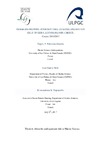Identificador persistente para citar o vincular este elemento:
https://accedacris.ulpgc.es/jspui/handle/10553/74968
| Campo DC | Valor | idioma |
|---|---|---|
| dc.contributor.advisor | García Weil, Luis Francisco | es |
| dc.contributor.advisor | Topouzelis, Konstantinos | es |
| dc.contributor.author | Palomino Gaviria, Ángela Patricia | es |
| dc.date.accessioned | 2020-10-23T09:15:27Z | - |
| dc.date.available | 2020-10-23T09:15:27Z | - |
| dc.date.issued | 2017 | en_US |
| dc.identifier.uri | https://accedacris.ulpgc.es/handle/10553/74968 | - |
| dc.description.abstract | Seagrass are globally important environments in terms of biodiversity preservation, and for the economic value their ecosystem services provide to human populations. Posidonia oceanica is one of the best studied species in the Mediterranean basin, its presence depends of some factors; They can withstand relatively large variations due to high plasticity such as, variation in temperature and hydrodynamism. On the other hand, Posidonia are sensitive with turbidity, rise of the sea level, salinity. Besides, eutrophication originated by anthropogenic pressure such as, fish farms, and submarine emissaries act on the Gulf and may affect the areas occupied by Posidonia. It is important to create monitoring programs to observe the changes that occur in the region inhabited by Posidonia in the coastal areas, to understand the stability and dynamics of the plant. Remote sensing is a reachable tool that handles the coverage and accuracy requirements needed for working in large scale in order to have control over the ecosystem. It is important to continue and to expand monitoring these areas occupied by this habitat. It is equally important to monitor through field work. In the present study, coastal seagrass habitats in the Gulf of Gera were classified by e- Cognition® software using multispectral high-resolution imaging data recorded with a new sensor on-board of Sentinel-2 satellite, and ArcGIS 10.2® software to obtain the images. An important feature of the remote sensor on board on Sentinel-2A satellite is its multispectral character with bands with different spatial and spectral resolutions. The different methodologies used, and the maps elaborated were an important tool to compare benthic composition, especially for seagrass detection. The accuracy assessment using atmospheric correction and all bands showed a Kappa coefficient of 0.96817, indicating that it was the best process for the detection and classification of the meadows in this case. Moreover, seagrass study using field observations obtained by scuba diving contributes to improve the detection and the classification. The field data contribute to verifying and confirming the satellite images, avoiding remote sensing errors and obtaining better results. | en_US |
| dc.language | eng | en_US |
| dc.subject | 241705 Biología marina | en_US |
| dc.subject | 250616 Teledetección (Geología) | en_US |
| dc.subject.other | Seagrass meadows | es |
| dc.subject.other | Posidonia oceanica | es |
| dc.subject.other | Remote sensing | es |
| dc.subject.other | Accuracy | es |
| dc.subject.other | Sentinel-2A | es |
| dc.subject.other | Mapping | es |
| dc.subject.other | GIS | es |
| dc.title | Seagrass mapping with Sentinel-2A satellite in Gulf of Gera, Lesvos Island, Greece | es |
| dc.type | info:eu-repo/semantics/bachelorThesis | en_US |
| dc.type | BachelorThesis | en_US |
| dc.contributor.departamento | Departamento de Física | es |
| dc.contributor.facultad | Facultad de Ciencias del Mar | en_US |
| dc.investigacion | Ciencias | en_US |
| dc.type2 | Trabajo final de grado | en_US |
| dc.utils.revision | Sí | en_US |
| dc.identifier.matricula | TFT-42295 | es |
| dc.identifier.ulpgc | Sí | en_US |
| dc.contributor.buulpgc | BU-BAS | es |
| dc.contributor.titulacion | Grado en Ciencias del Mar | es |
| item.grantfulltext | restricted | - |
| item.fulltext | Con texto completo | - |
| crisitem.advisor.dept | GIR IUNAT: Física marina y teledetección aplicada | - |
| crisitem.advisor.dept | IU de Estudios Ambientales y Recursos Naturales | - |
| crisitem.advisor.dept | Departamento de Física | - |
| Colección: | Trabajo final de grado Restringido ULPGC | |
Visitas
179
actualizado el 31-oct-2024
Descargas
94
actualizado el 31-oct-2024
Google ScholarTM
Verifica
Comparte
Exporta metadatos
Los elementos en ULPGC accedaCRIS están protegidos por derechos de autor con todos los derechos reservados, a menos que se indique lo contrario.
